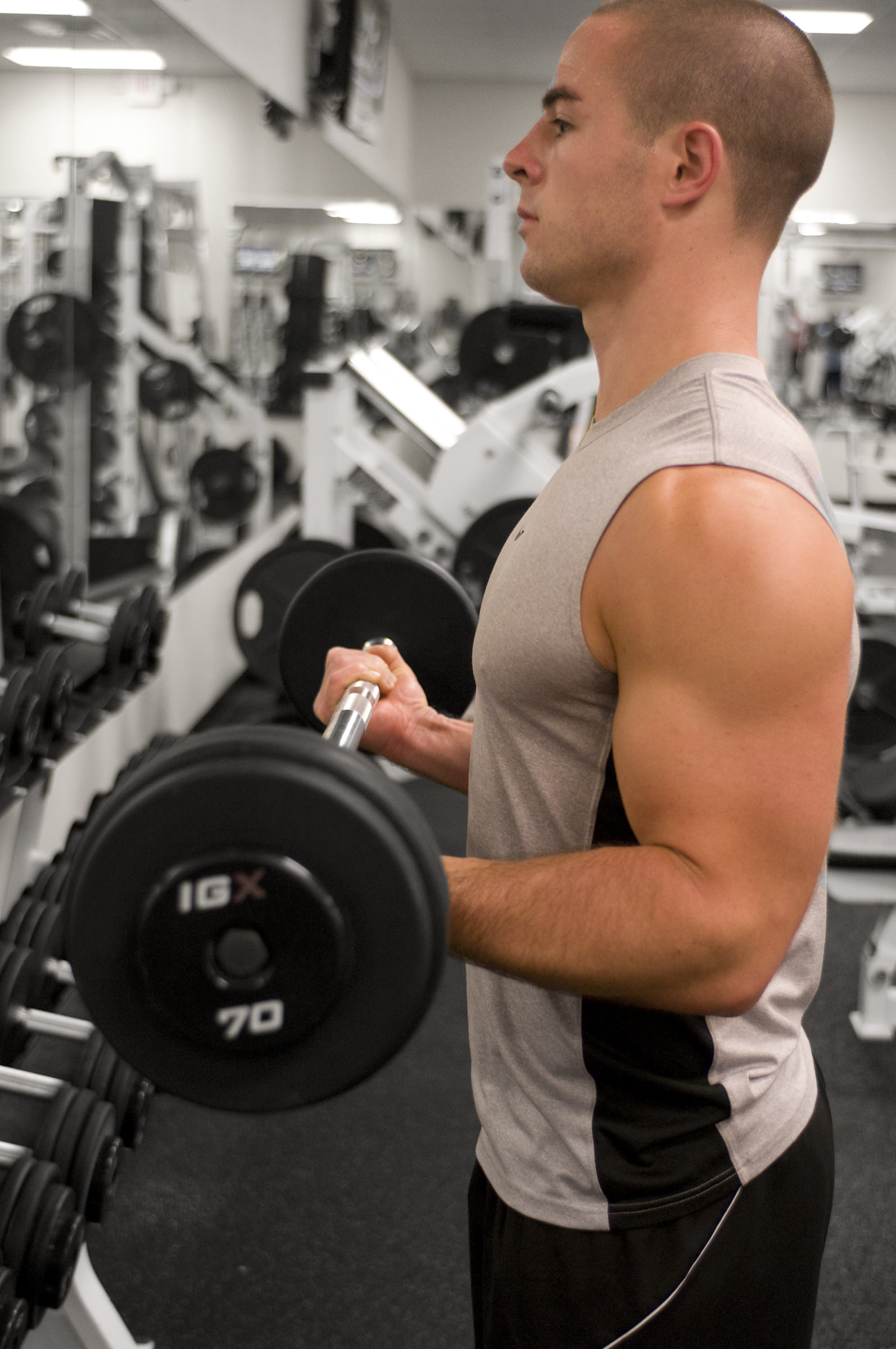The Squat.

Well, do you want to learn how to do a proper squat?
- Position yourself under the barbell with your chest high and your back straight.
- Grip the barbell as close to your head as possible. Now you don’t want to be touching your ears, but the closer your hands are to your head, the tighter your upper back will be, and the better the bar will be positioned. You want to use a thumbless grip. You aren’t supporting the bar with your hands, you are holding the bar in position against your back. Your forearm and wrists should create a straight line, with no bending.
- Make sure the bar is positioned across your lower traps, while elevating your elbows as high as you can behind you. Is your chest still upright? Make sure it is!
- Squat the barbell out of the rack, but make sure you do not lean forward.
- When clearing the rack: step backward with one foot, step backward with the trailing foot, and use the trailing foot to get your legs into shoulder width stance.
- Keep your chest upright with the bar balanced, inhale deeply, and squat all the way down. Do not look up, do not look down, and do not look sideways. Keep your head straight and focus on a point that is 2-3 feet above the wall in front of you.
- When you go into your squat, make sure you are pushing your butt outward, and bending your knees. Your upper body will remain upright and you will be slightly leaning forward. Always keep tension in your knees and quads, do not simply drop into position.
- Exhale as you are completing the rep.
Well known Mark Rippetoe on the Squat:
There is simply no other exercise, and certainly no machine, that produces the level of central nervous system activity, improved balance and coordination, skeletal loading and bone density, muscular stimulation and growth, connective tissue stress and strength, psychological demand and toughness, and overall systemic conditioning as the correctly performed full squat.
I’ll tell you from personal experience – when you do squats for the first time your legs will be freakin’ sore the next day. The soreness isn’t dangerous so don’t worry, they are just the DOMS (delayed onset muscle soreness) of the thigh and glute areas. Just waddle along, push through the pain, and get under the damn bar!
The Deadlift.
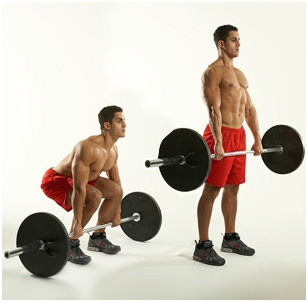
As a beginner, you will always want to start and end with the deadlift with the bar on the floor. This limits the weight you can use, as there is no stretch reflex or bouncing of the bar on the floor. Make sure you pull from the floor – every single rep, and every single set – no excuses. Later on we will learn about marginal reps, but in the beginning phase you want your muscles to properly learn the form and positioning of doing a complete deadlift.
After all that, let’s learn how to do a proper deadlift:
- Stand with your feet shoulder wide, and the balls of your feet directly under the bar. Your toes should be pointing forward or slightly outward.
- Bend your knees and “sit back” so that you are within reach of the bar.
- Grasp the bar with your arms outside of your legs, and slightly wider that shoulder width apart.
- Lower your hips so that your thighs are parallel to the ground, and keep the lower portion of your legs vertical. The angle between your shins and thighs should be ~90 degrees.
- Make sure that your back is straight and you are looking straight ahead. Inhale deeply and begin to stand up by raising your hips and shoulders.
- You always want to maintain a flat back and keep your core contracted as you are lifting. Exhale toward the end of the lift, where you shoulders will be slightly pulled back and the bar will be at hip level. Be sure to keep the bar close to your body.
- Put the bar back down on the floor, as if you were going to sit down in a chair, while maintaining a straight back and straight head.
If you are having any problems with your grip, do NOT get gloves. Instead, get some chalk and use it excessively – gloves will weaken your grip over time. If you are still not happy with your grip strength then do as many reps as you can with double overhand grip, and switch to double underhand with your heavier sets. Alternating your grip positioning will develop your grip insanely fast so there is no need for a beginner to use gloves.
The Bench Press.
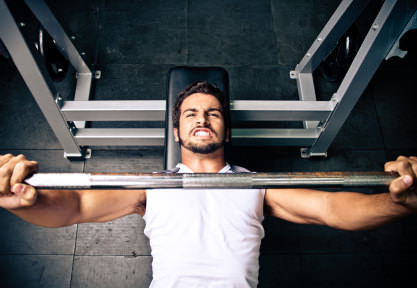
Now, let’s hit the bench and try not to make a show out of ourselves:
- Lie down flat on the bench, ensuring that you are even on both sides. Trust me here, you don’t want to make a fool of yourself and fall off the bench!
- Your feet will be touching the ground at all times, so if you need to get blocks or extra plates to reach – do it. You will never raise your feet off of the ground, and you will want to keep a comfortable stance throughout your sets.
- Your glutes will always be in contact with the bench, and be contracted at all times you are doing your reps.
- Pinch your shoulder blades together and under your body to ensure stability. This will lift your ribcage and create a natural arch in your lower back that will help promote balance of your upper back muscles to press with.
- Keeping your shoulder blades tight, raise your hands up and place them equal distance from the center of the barbell. Let the bar rest on the heel of your hands, and take grip of the bar.
- Lift the bar to unrack it and hold it directly over your lower chest. Make sure that you take your time with this motion, as unracking the bar diagonally can unbalance you – which will ensue embarrassment.
- Take a deep breath, and while maintaining tightness in the upper chest, bring the bar down to your chest. The idea here is to not let your elbows tuck or flare excessively, but to have an angle ~40-60 degrees from your torso.
- You don’t want the bar bouncing off of your chest (it will hurt); when you lower the bar let it touch your shirt.
- Press the bar in a controlled fashion, making sure that your elbows do not extend outward and your shoulders always keep contact with the bench. Keep the bar even so that it does not wobble. The final rep in your set will stop at the top, where you can rest the bar back onto the rack.
The biggest mistake that you see in beginners trying to bench press is the “Hip hop bounce press”. This happens when your hips come off of the bench to assist with the lift, and undoubtedly is accompanied by the bar bouncing off of the chest. If you see this happening to someone, take the simple joy of entertainment and try not to laugh too hard.
The Press.
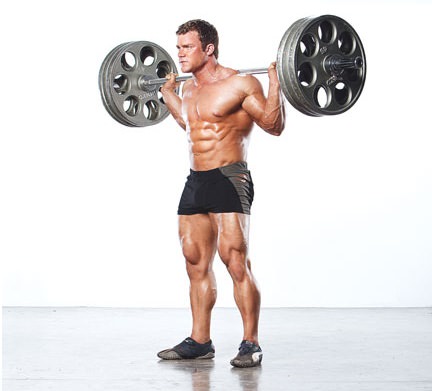
Push presses are a fantastic way to develop strength and power in your delts, traps, and upper back. You can perform these behind the neck, but stick to the basics for now as it requires more flexibility to be performed safely.
Let’s get started, shall we?
- With the barbell on the ground, stand with feet shoulder width apart and grip the barbell just outside of shoulder width.
- Bend your knees slightly and raise the barbell to your collar bone. You can take a step back to re-position stance or grip if needed while resting the bar on your chest.
- Raise the barbell over your head by locking your elbows and bring it level with your shoulders. This will be your starting position.
- Push the barbell upward while exhaling to an overhead position.
- When clearing your head, only lean your head back. You do not need to move any other part of your body – you must not lean backwards.
- Once you have cleared your head, you will allow your head to come forward so the bar is directly over your spine.
- Lower the bar to be level to your shoulders.
One thing to remember is to always keep your chest elevated throughout the entire exercise. You don’t want to arch or round your upper or lower back during the exercise, you want your back tight and in proper alignment to give the added support.
The Row.
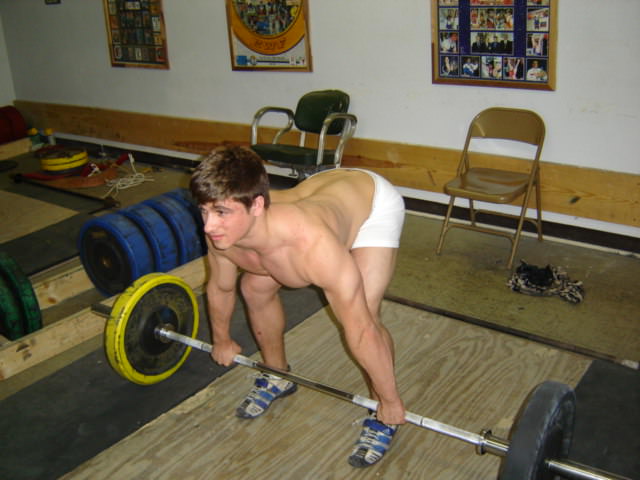
Always keep proper form during this exercise! Here’s how to do a Pendlay Row:
- You will start with the barbell on the ground and lean over using your hips. Make sure when you lean over to keep your natural lumbar arch. Yes your butt will stick out, and yes you have to deal with it.
- Reach for the bar and grasp it with a wide grip. It’s up to you on your grip width, but anywhere outside of shoulder width that is comfortable is fine. Reaching for the bar without arching your lower back will round your shoulders forward, this is natural.
- Inhale deeply while keeping your core and lower back contracted, and arch your shoulder blades backwards and upwards – letting your elbows follow behind your body. You want to maintain your natural lower back arch make sure there is no motion from the hips.
- The bar will hit your lower abs as you are pulling the bar “through” your body, while squeezing your shoulder blades together and arching your lats.
- Return the barbell to the ground while controlling it and maintaining your lumbar arch. Don’t just drop it on the floor.
- You should relax your grip each time the bar is on the ground in order to remove any static tension in the muscles.
These are a solid foundation of exercises for any beginner to master, allowing proper development and learning the focus needed for proper form.
